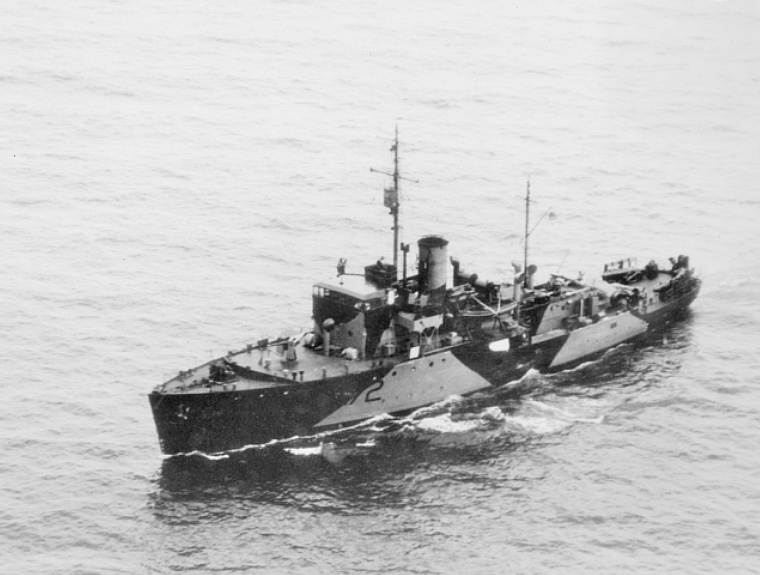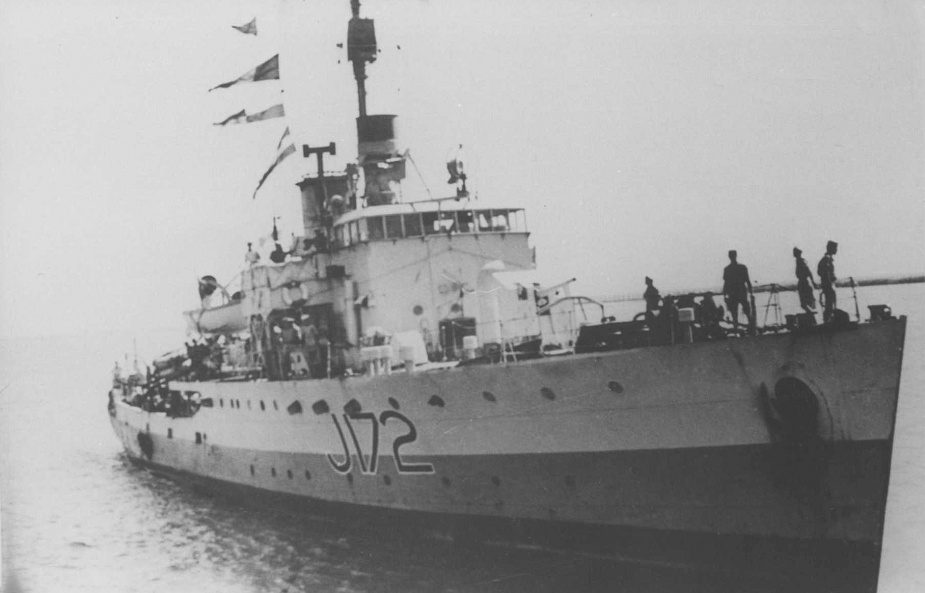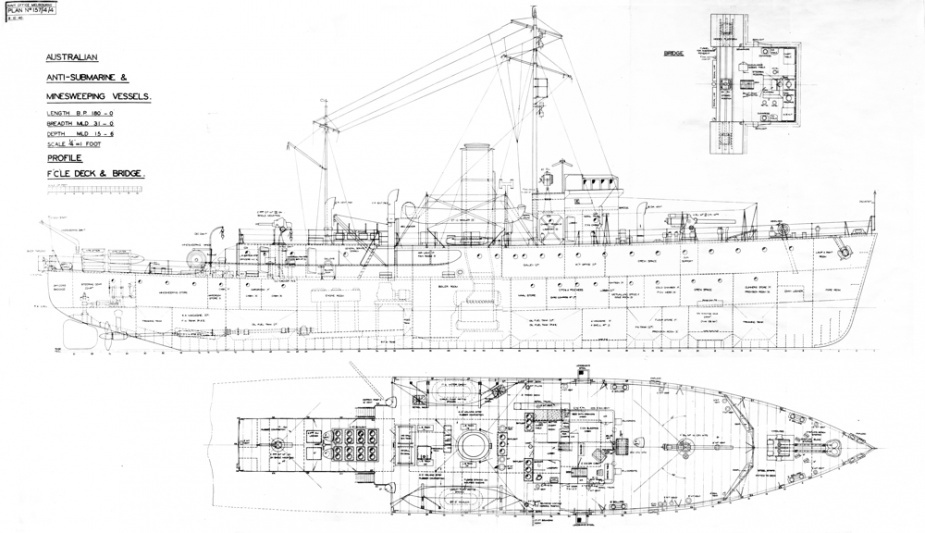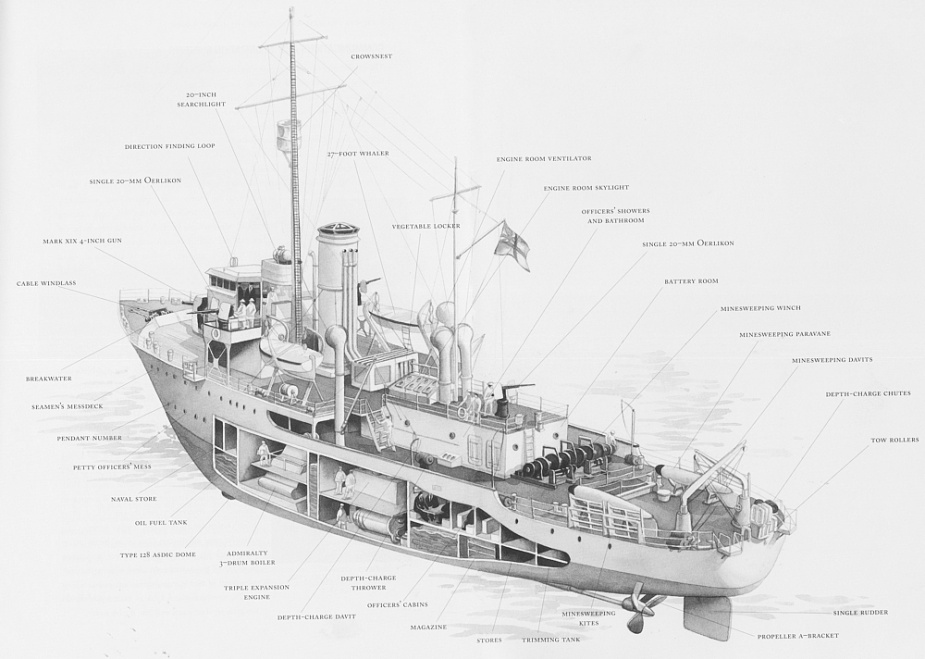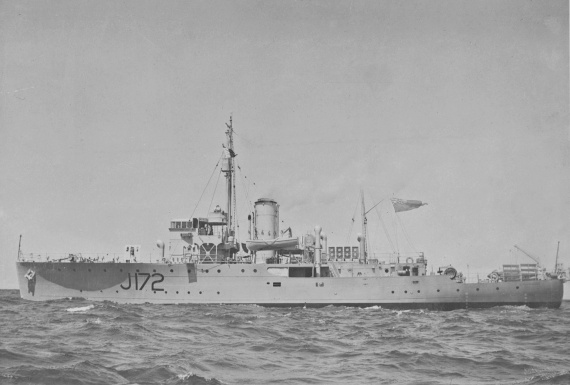
Wollongong at sea during acceptance trials. Note the red ensign flying from its mainmast.
HMAS Wollongong (I) was one of 60 Australian Minesweepers (commonly known as corvettes) built during the Second World War in Australian shipyards as part of the Commonwealth Government’s wartime shipbuilding program. Twenty (including Wollongong) were built on Admiralty order but crewed and commissioned by the Royal Australian Navy (RAN). Thirty-six were built for the RAN and 4 for the Royal Indian Navy.
Wollongong was laid down on 21 January 1941 at Cockatoo Docks and Engineering, Sydney. It was launched by Mrs Beasley, wife of the minister of Supply and Shipping on 5 July 1941 and commissioned at Sydney on 23 October 1941 under the command of Lieutenant Gordon A Keith RANR(S).
Wollongong began its operational career escorting merchant convoys on the east coast of Australia.
On 11 January 1942 Wollongong departed Darwin for Singapore in company of ships of the same class HMAS Toowoomba (I) and HMAS Ballarat (I), undertaking escort, patrol and evacuation duties throughout the campaigns in Malaya, Java and Sumatra. It sailed from Singapore at midnight on the night of 6 February 1942, with Commander Farquharson and his staff on board who had been responsible for operating the Australian AMS vessels throughout the Singapore campaign.
Wollongong was the last Australian warship to leave before the city’s surrender to Japanese forces on 15 February. Picking up HMAS Bendigo (I), which had left Singapore a few hours earlier, Wollongong (I) proceeded first to Palembang, where the 2 ships joined Ballarat and Toowoomba.
With the Allied situation rapidly deteriorating as the enemy advance continued, Wollongong sailed from Tanjong Priok, Batavia, at about midnight on the night of 27 February 1942 as rear escort of a convoy of 6 ships, the main escorts of which were the sloops HMAS Yarra (II) and HMIS Jumna. One of the vessels, the minesweeper HMS Gemas, turned back to Tanjong Priok and had to be sunk on 2 March by Ballarat to prevent its capture.
Some 4 hours after the convoy sailed the tanker HMS War Sirdar ran aground on a reef west of Tanjong Priok. Wollongong detached and stood by until daylight when it made repeated but unsuccessful attempts to tow the tanker off the reef. The efforts were terminated by an enemy air attack and Wollongong set off to rejoin the convoy after advising War Sirdar to abandon ship and land on a nearby island. Commodore J A Collins CB RAN (commanding the American, British, Dutch, Australian Detachment of the Eastern Fleet) was advised.
Further misfortune befell the convoy after dark on 28 February, when the tanker SS British Judge was torpedoed south of Sunda Strait. However, it remained afloat and proceeded to Tjilatjap some distance astern of the convoy at slow speed and escorted by Wollongong.
When the convoy arrived off Tjilatjap, Commodore Collins ordered Jumna to Colombo, and Yarra and the convoy to Fremantle. British Judge intercepted the signal to Jumna and passed it to Wollongong, who instructed the latter to make for Colombo independently, while Wollongong set course for Fremantle. Wollongong’s detachment from the convoy almost certainly saved the ship from destruction. Yarra and its 3 remaining charges, the depot ship HM Anking, the tanker HMS Francol and the minesweeper MMS 51 were sunk south of Java on 4 March by a strong Japanese force.
Following a period of escort duties in Western Australian waters, Wollongong departed Fremantle on 14 September 1942 for Diego Garcia to join the Eastern Fleet. For more than 2 years it operated on escort and patrol in the Indian Ocean, Persian Gulf and Arabian Sea, except for a period from mid-1943 to the end of September in that year when it served in the Mediterranean.
On 13 July 1943, 3 days after the start of the Allied invasion of Sicily, Wollongong, with ships of the same class HMAS Cairns (I), HMAS Cessnock (I) and HMAS Geraldton (I), visited the island as part escort of a convoy from Alexandria. They spent the day carrying out an endless chain patrol off the beach and saw an American Liberty ship blown up in an air raid.
On 2 occasions (one in August and one in September) Wollongong entered the Atlantic to rendezvous with Mediterranean bound convoys for which it acted as part escort. Each comprised 75 ships.
Late on the night of 11 September 1943 the German submarine U-617 was attacked in the western Mediterranean by a Wellington aircraft of 179 Squadron, RAF. The U-boat was seriously damaged, and after 15 minutes moved off slowly on the surface for the North African coast. In the early hours of 12 September another Wellington from 179 Squadron also attacked and damaged the submarine. U-617 beached on the shore of Spanish Morocco at 2 am. The crew abandoned ship under gun fire from the requisitioned Dutch trawler Haarlem. The corvette HMS Hyacinth, with Wollongong under its orders, later arrived at the scene and the 2 ships shelled the U-boat. The destruction of U-617 was credited to the 2 aircraft of 179 Squadron, Haarlem, Hyacinth and Wollongong.
Wollongong returned to home waters when it arrived in Fremantle on 16 May 1944 for a 2-month refit. On completion of the refit, it sailed from Fremantle for further service with the Eastern Fleet.
Wollongong completed its service with the Eastern Fleet when it returned to Australia in February 1945. The concluding months of hostilities were spent chiefly in the Manus area. This included taking part in the operation for the capture of Okinawa (Operation ICEBERG) between March and May 1945.
At 11 am on 9 June 1945, Wollongong berthed at Port Kembla to visit its namesake city. Owing to the minimum depth of water at Wollongong, and to the regret of the local council, the corvette was unable to berth any closer. The mayor and councillors met the ship on arrival and were duly welcomed by the commanding officer. The officers were hosted at a civic reception at the Town Hall, while its ship’s company were transported to Wollongong to march through the main street to the War Memorial where a wreath was laid. Afterwards they were entertained at a luncheon and into the evening.
In the immediate postwar period, Wollongong proceeded to the Far East and spent a few weeks on anti-piracy patrols followed by a brief period of service at Morotai.
On 11 February 1946 Wollongong paid off at Sydney in preparation for transfer to the Royal Netherlands Navy. It had steamed more than a quarter of a million miles during its commission with the RAN.
Renamed Banda, it served with the Royal Netherlands Navy until April 1950 when it was handed over to the newly created Indonesian Navy and renamed Radjawali. Jane’s Fighting Ships reported that Radjawali arrived at Hong Kong in April 1968 for scrapping.
Specifications
 |
| Class |
Bathurst Class |
|---|---|
| Type |
Australian Minesweeper (Corvette) |
| Pennant |
J172 |
| Motto |
Second to None |
| Builder |
Cockatoo Docks and Engineering Co Ltd, Sydney |
| Laid Down |
29 January 1941 |
| Launched |
5 July 1941 |
| Launched by |
Mrs Beasley, wife of the Minister for Supply and Shipping |
| Commissioned |
23 October 1941 |
| Decommissioned |
11 February 1946 |
| Fate |
Renamed Banda she served with the Royal Netherlands Navy until April 1950, when she was handed over to the newly created Indonesian Navy, being renamed Radjawali. ‘Jane"s Fighting Ships’ reported that Radjawali arrived at Hong Kong in April 1968 for scrapping. |
| Dimensions & Displacement | |
| Displacement | 650 tons |
| Length | 186 feet |
| Beam | 31 feet |
| Draught | 8 feet 6 inches |
| Performance | |
| Speed | 15 knots |
| Complement | |
| Crew | 85 |
| Propulsion | |
| Machinery | Triple Expansion, 2 Shafts |
| Horsepower | 2000 |
| Armament | |
| Guns |
|
| Other Armament |
|
| Radars | Types 271 & 291 Radar |
| Awards | |
| Battle Honours |
|

